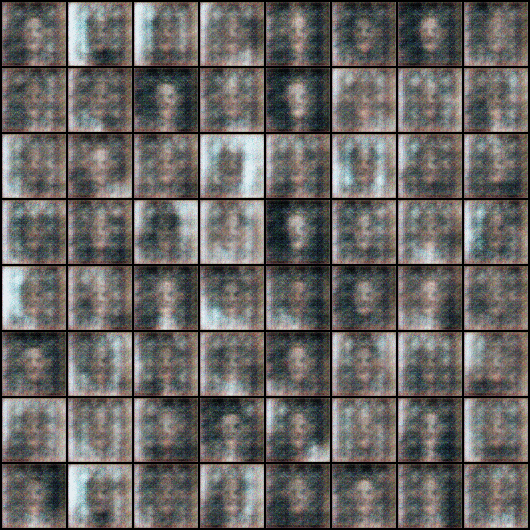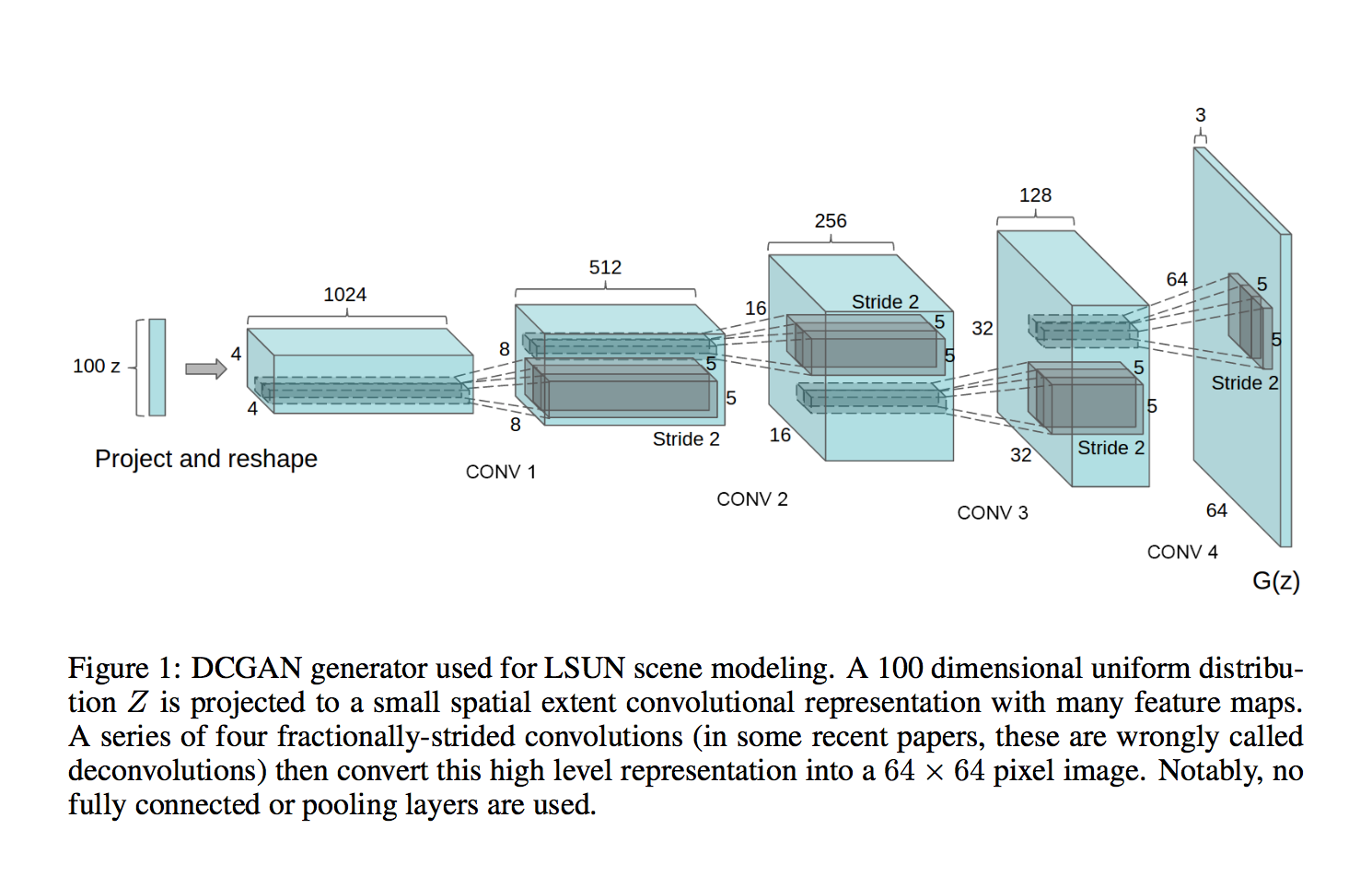floydhub / Dcgan
Programming Languages
Projects that are alternatives of or similar to Dcgan
Deep Convolutional Generative Adversarial Networks - DCGANs
This project implements the paper Unsupervised Representation Learning with Deep Convolutional Generative Adversarial Networks from a porting of pytorch/examples/dcgan making it usables on FloydHub.
The implementation is very close to the Torch implementation dcgan.torch.
Before start, the fixed_noise.pth (serialized Z vector used for generating image on training) is saved in the outf folder.
After every 100 training iterations, the files real_samples.png and fake_samples.png are written to disk
with the samples from the generative model.
After every epoch, models are saved to: netG_epoch_%d.pth and netD_epoch_%d.pth
Downloading the LSUN dataset
You can download the LSUN dataset by cloning this repo and running
python download.py -c bedroom
Usage
Training script:
usage: main.py [-h] --dataset DATASET --dataroot DATAROOT [--workers WORKERS]
[--batchSize BATCHSIZE] [--imageSize IMAGESIZE] [--nz NZ]
[--ngf NGF] [--ndf NDF] [--niter NITER] [--lr LR]
[--beta1 BETA1] [--cuda] [--ngpu NGPU] [--netG NETG]
[--netD NETD]
optional arguments:
-h, --help show this help message and exit
--dataset DATASET cifar10 | lsun | imagenet | folder | lfw
--dataroot DATAROOT path to dataset
--workers WORKERS number of data loading workers
--batchSize BATCHSIZE
input batch size
--imageSize IMAGESIZE
the height / width of the input image to network
--nz NZ size of the latent z vector
--ngf NGF
--ndf NDF
--niter NITER number of epochs to train for
--lr LR learning rate, default=0.0002
--beta1 BETA1 beta1 for adam. default=0.5
--cuda enables cuda
--ngpu NGPU number of GPUs to use
--netG NETG path to netG (to continue training)
--netD NETD path to netD (to continue training)
Generating script:
usage: generate.py [-h] --netG NETG [--outf OUTF] [--Zvector ZVECTOR] [--cuda]
[--ngpu NGPU]
optional arguments:
-h, --help show this help message and exit
--netG NETG path to netG (for generating images)
--outf OUTF folder to output images
--Zvector ZVECTOR path to Serialized Z vector
--cuda enables cuda
--ngpu NGPU number of GPUs to use
DCGAN Architecture
Run on FloydHub
Follow the tutorial on the FloydHub docs or follow the next steps:
Project Setup
Before you start, log in on FloydHub with the floyd login command, then fork and init the project:
$ git clone https://github.com/floydhub/dcgan.git
$ cd dcgan
$ floyd init dcgan
Training
This project support the following datasets which were used in the paper:
- LSUN, coming soon on FloydHub Dataset, but you can download it following the above command
- CIFAR-10, available on FloydHub here
- ImageNet, available on FloydHub here
- LFW, available on FloydHub here
- Custom Image Dataset Folder, now it's your turn to make new experiments :)
Now it's time to run our training on FloydHub. In this example we will train the model for 100 epochs with a gpu instance and with cuda enabled. Note: If you want to mount/create a dataset look at the docs.
$ floyd run --gpu --env pytorch-0.2 --data redeipirati/datasets/lfw/1:lfw "python main.py --dataset lfw --dataroot /lfw --outf trained_models --cuda --ngpu 1 --niter 100
You can follow along the progress by using the logs command. The training should take about 2h!!
Evaluating
It's time to evaluate our model generating some images:
floyd run --gpu --env pytorch-0.2 --data <REPLACE_WITH_JOB_OUTPUT_NAME>:/model "python generate.py --netG /model/trained_models/<REPLACE_WITH_MODEL_CHECKPOINT_PATH> --ngpu 1 --cuda"
# Provide a serialized Zvector
floyd run --gpu --env pytorch-0.2 -data <REPLACE_WITH_JOB_OUTPUT_NAME>:/model "python generate.py --netG /model/trained_models/<REPLACE_WITH_MODEL_CHECKPOINT_PATH> --Zvector <REPLACE_WITH_SERIALIZED_Z_VECTOR_PATH> --ngpu 1 --cuda"
Try our pre-trained model
We have provided to you a pre-trained model trained on the lfw-dataset for about 300 epochs.
floyd run --gpu --env pytorch-0.2 --data redeipirati/datasets/dcgan-300-epochs-models/1:/model "python generate.py --netG /model/netG_epoch_299.pth --ngpu 1 --cuda"
Serve model through REST API
If you run a job with --mode serve flag, FloydHub will run the app.py file in your project
and attach it to a dynamic service endpoint:
floyd run --gpu --mode serve --env pytorch-0.3 --data <REPLACE_WITH_JOB_OUTPUT_NAME>:/input
The above command will print out a service endpoint for this job in your terminal console.
The service endpoint will take a couple minutes to become ready. Once it's up, you can interact with the model by sending serialized Z vector file with a POST request or simply generating images from random noise:
# e.g. of a GET req
curl -X GET -o <NAME_&_PATH_DOWNLOADED_IMG> -F "ckp=<MODEL_CHECKPOINT>" <SERVICE_ENDPOINT>
curl -X GET -o prova.png -F "ckp=netG_epoch_99.pth" https://www.floydlabs.com/serve/redeipirati/projects/dcgan
# e.g. of a POST req
curl -X POST -o <NAME_&_PATH_DOWNLOADED_IMG> -F "[email protected]<ZVECTOR_SERIALIZED_PATH>" <SERVICE_ENDPOINT>
curl -X POST -o prova.png -F "[email protected]/parameter/zvector.pth" https://www.floydlabs.com/serve/redeipirati/projects/dcgan
Any job running in serving mode will stay up until it reaches maximum runtime. So once you are done testing, remember to shutdown the job!
More resources
Some useful resources on DCGAN:
- DCGAN slide
- Paper explained
- Quora GAN
- OpenAI GAN
- Ian Goodfellow, Research Scientist OpenAI : Generative Adversarial Networks
Contributing
For any questions, bug(even typos) and/or features requests do not hesitate to contact me or open an issue!


